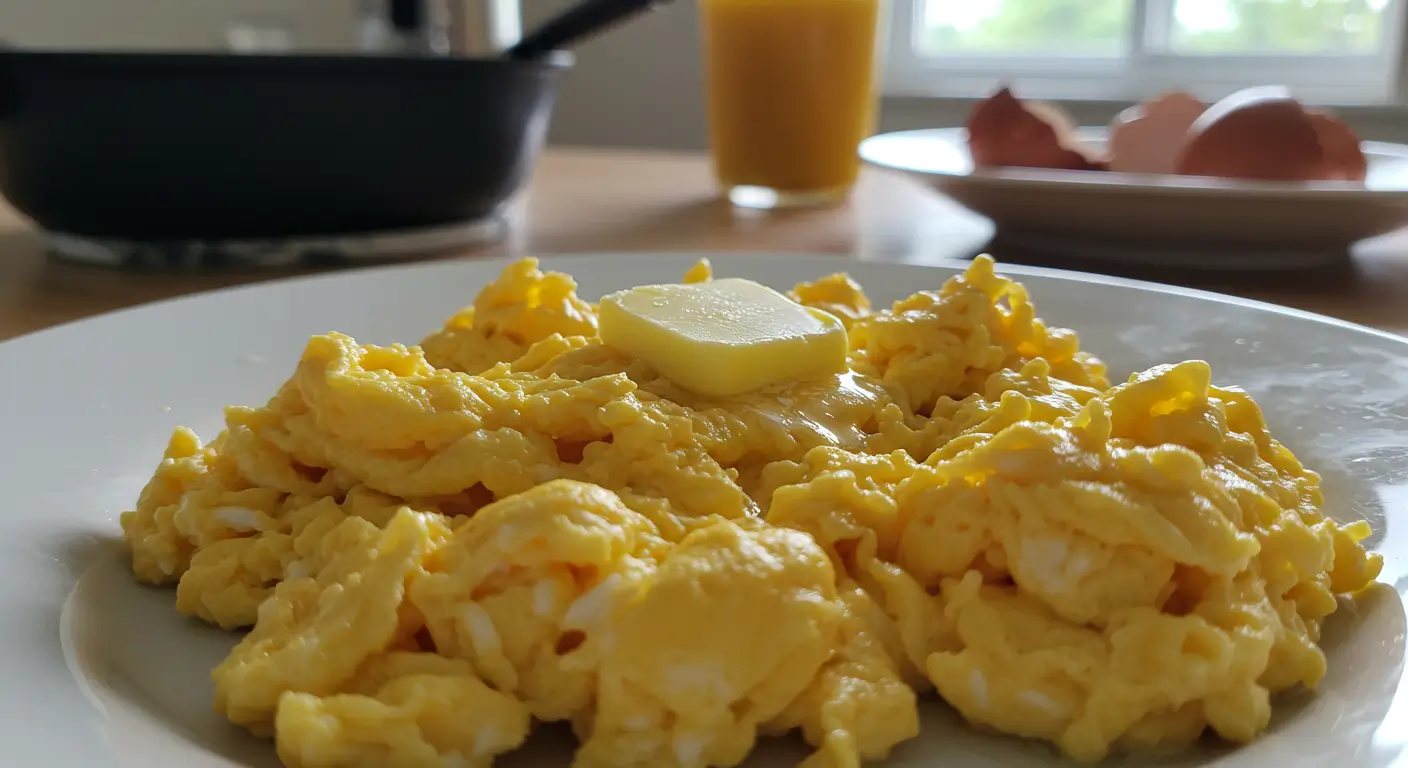So here’s the embarrassing truth: I’m 28 years old and I only learned how to make decent scrambled eggs last month. Twenty-eight. Years. Old.
I know what you’re thinking—how do you mess up scrambled eggs? They’re literally eggs. Scrambled. Well, let me tell you, I found every possible way to turn perfectly good eggs into rubber bouncy balls that could probably substitute for actual sporting equipment.
My mom tried to teach me when I was like twelve, but I was too busy being a know-it-all teenager. “Just crack them in the pan and stir, Mom. It’s not rocket science.” Famous last words from someone who would spend the next decade and a half eating what can only be described as egg-flavored erasers.
But then my roommate Jake made scrambled eggs one Sunday morning, and I literally stopped mid-bite and stared at him. They were… fluffy? Creamy? They didn’t require a steak knife to cut through? What kind of sorcery was this?
Table of Contents :
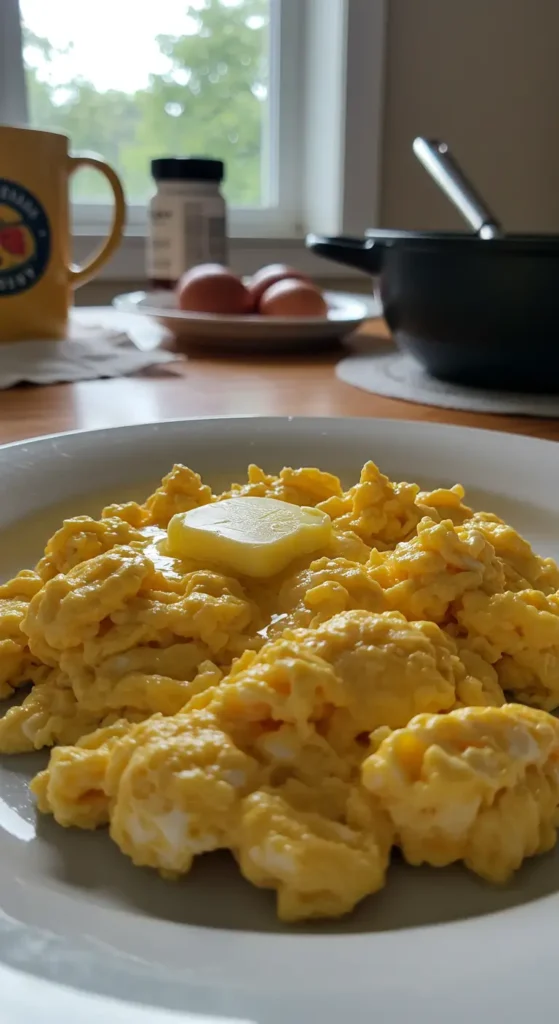
My Wall of Shame :
Before we get to the good stuff, let me paint you a picture of my scrambled egg journey. It’s been… rough.
The High Heat Hero Phase: Thought higher heat = faster cooking = better eggs. Wrong. So wrong. Ended up with eggs that were simultaneously burned on the bottom and raw on top. Physics doesn’t work that way, past me.
The “Just Leave Them Alone” Era: Read somewhere that you shouldn’t over-stir eggs. Took this to mean “crack them in the pan and walk away to check Instagram.” Came back to what looked like a yellow frisbee. My dog was interested. I was not.
The Milk Madness Period: Someone told me adding milk makes eggs fluffier. Added half a cup of milk to three eggs because more = better, right? Created egg soup. Gross, gross egg soup.
The Cheese Overload Incident: Figured cheese fixes everything (which, to be fair, it usually does). Added so much cheddar that it looked like a science experiment. Tasted like one too.
But the worst? The absolute worst was when I tried to be fancy and make them in the microwave for my then-boyfriend. Thirty seconds turned into two minutes because I got distracted by a text. The eggs exploded. Literally exploded. There were egg bits stuck to the microwave ceiling. We broke up three weeks later. Probably unrelated, but still.
The Game-Changer Moment :
So back to Jake and his magical Sunday morning eggs. I’m sitting there, fork halfway to my mouth, probably looking like I’d just witnessed a miracle. Which, let’s be honest, I basically had.
“Dude, what did you do to these eggs?” I asked, probably with my mouth full because I have no manners when I’m shocked.
“Low heat. Butter. Patience,” he said, like he was some kind of egg philosopher.
Patience. That was my problem. I’d been treating scrambled eggs like they were in some kind of race. Turns out, good eggs are like good relationships—they need time and attention.
The Method That Actually Works :
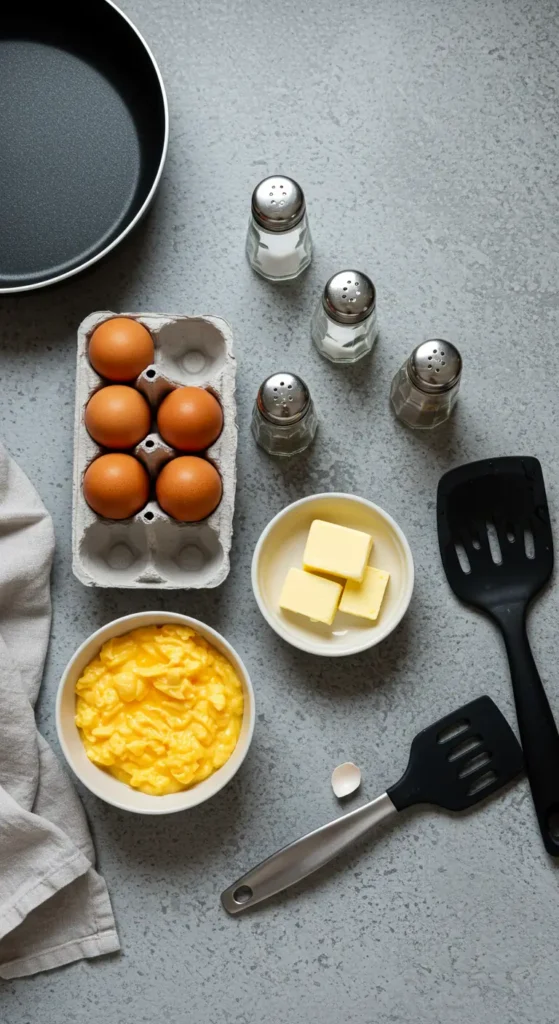
Alright, here’s what changed everything. And I mean everything. I’ve made these eggs probably fifty times in the past month because I’m slightly obsessed now.
What You Need:
- 3 large eggs (I use whatever’s cheapest, we’re not fancy here)
- 2-3 tablespoons butter (real butter, not that fake stuff)
- 2-3 tablespoons heavy cream or milk (heavy cream is better but milk works)
- Salt and pepper to taste
- A non-stick pan (trust me on this one)
- A silicone spatula (wooden spoon works too)
The Step-by-Step (That I Wish Someone Had Taught Me Years Ago):
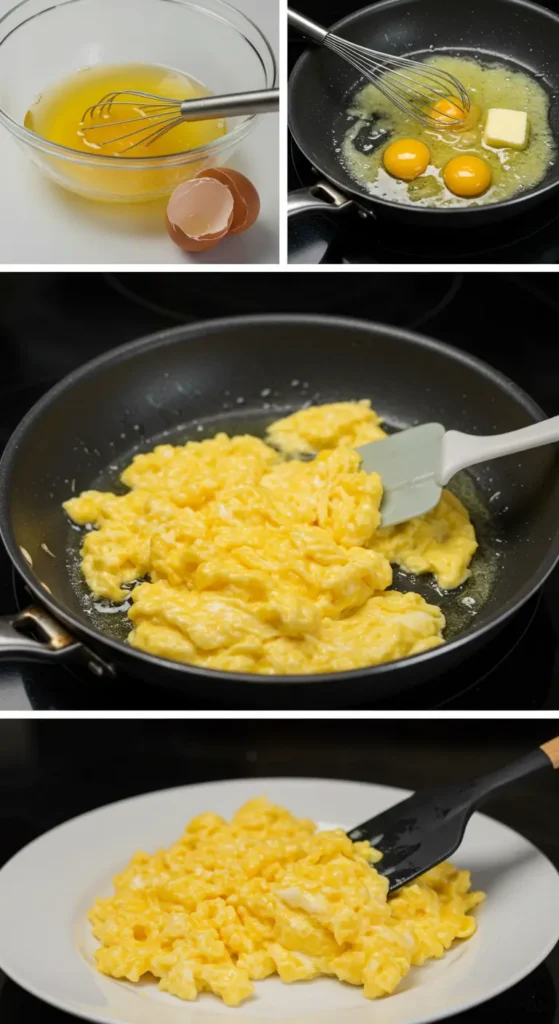
Step 1: Crack your eggs into a bowl. Yeah, a bowl. Not directly into the pan like some kind of breakfast rebel. I learned this the hard way when I got shell pieces in my eggs and spent ten minutes fishing them out with a spoon.
Step 2: Add your cream (or milk), salt, and pepper. Now here’s the key—whisk them like your life depends on it. I’m talking aggressive whisking. Get some air in there. The mixture should be pale yellow and slightly frothy.
Step 3: Heat your pan on LOW heat. And when I say low, I mean low. Like, so low you’re questioning if the stove is even on. Add butter and let it melt slowly. No browning, no sizzling, just gentle melting.
Step 4: Pour in your egg mixture. Here’s where it gets weird—don’t do anything. Just let them sit for like 30 seconds. I know it feels wrong. Do it anyway.
Step 5: Now start stirring. But not like you’re mixing cement. Gentle, slow movements with your spatula. Push the eggs from the outside edges toward the center, tilting the pan so the liquid egg flows underneath.
Step 6: Keep doing this. Slowly. Patiently. It takes like 5-8 minutes, which feels like forever when you’re hungry, but trust the process.
Step 7: When they look almost done but still slightly wet, take them off the heat. They’ll keep cooking from the residual heat. This is where I used to mess up—I’d leave them on the heat until they were “done” and end up with overcooked sadness.
Step 8: Give them one final gentle stir and serve immediately.
The Things I Wish I’d Known Sooner :
Temperature is everything. I cannot stress this enough. Low and slow is the way to go. High heat is the enemy of good scrambled eggs. It’s like trying to have a deep conversation while someone’s screaming at you—it just doesn’t work.
Butter is not optional. I tried making them with cooking spray once because I was trying to be “healthy.” They stuck to the pan and tasted like cardboard. Some things are worth the calories.
The cream makes all the difference. It keeps them moist and adds this richness that milk just can’t match. But if you only have milk, use milk. We’re not gatekeeping breakfast here.
Size matters. Don’t try to make eggs for six people in a tiny pan. They won’t cook evenly, and you’ll end up frustrated. Use a bigger pan or make smaller batches.
My Current Obsessions :
Now that I’ve figured out the basic technique, I’ve been going a little crazy with variations:
The Fancy One: Add cream cheese about halfway through cooking. It gets all melty and creates these amazing creamy pockets. Feels very sophisticated.
The Herb Situation: Fresh chives folded in at the very end. Makes me feel like I’m at a fancy brunch place, not standing in my kitchen in yesterday’s pajamas.
The Breakfast Sandwich Champion: Make them slightly underdone, pile them on a toasted everything bagel with hot sauce. Life-changing.
The Leftover Magic: Add whatever cheese is dying in my fridge. Last week it was some fancy gruyere my mom brought over. This week it’s probably going to be string cheese because that’s what I have.
The Mistakes I Still Make :
Even now that I “know” how to make scrambled eggs, I still mess up sometimes:
- Got impatient last Tuesday and cranked the heat. Rubber eggs strike again.
- Forgot to add salt once. Bland eggs are almost worse than overcooked eggs.
- Tried to multitask and make coffee at the same time. Burned the eggs while grinding beans. You’d think I’d learn.
- Made them in a regular pan instead of non-stick because it was already out. Spent fifteen minutes scraping egg off the bottom of the pan.
But here’s the thing—even my mistakes are edible now. Before, my mistakes went straight to the trash. Progress!
Real Talk: Why This Matters
I know we’re talking about scrambled eggs here, not like, world peace or anything. But there’s something about finally mastering this basic thing that I should have figured out years ago that just feels… good?
Like, I can make eggs now. Real eggs. Fluffy, creamy, actually-taste-good eggs. It’s such a simple thing, but it makes me feel weirdly accomplished every single morning.
Plus, my friends have started asking me to make breakfast when they come over, which never happened before. My reputation has gone from “Don’t let her near the kitchen” to “Actually, her eggs are pretty good.” Character development!
The Questions Everyone Asks :
“Can I add vegetables?” Sure, but cook them first. Raw veggies will make your eggs watery. I learned this with mushrooms. Soggy, sad mushrooms.
“What about cheese?” Add it near the end, when the eggs are almost done. It’ll melt perfectly without making everything greasy.
“How many eggs per person?” I usually do 2-3 eggs per person, depending on what else we’re having. More if it’s just eggs, fewer if there’s bacon involved.
“Can I make them ahead of time?” Technically yes, but they’re never as good reheated. Best to make them fresh if you can.
My Sunday Morning Routine Now :
These days, Sunday morning means proper scrambled eggs. I make coffee, put on some music, and actually take the time to do it right. It’s become this weird little ritual that I actually look forward to.
Sometimes I’ll make extra and meal prep them for the week (they reheat better than you’d think), but usually I just make enough for right now. There’s something nice about the whole slow process. Very zen. Very unlike my usual chaotic morning routine.
Last weekend, my mom came over and I made her scrambled eggs. She took one bite and said, “Finally! I knew you could do it.” Twenty-eight years of patience on her part, apparently.
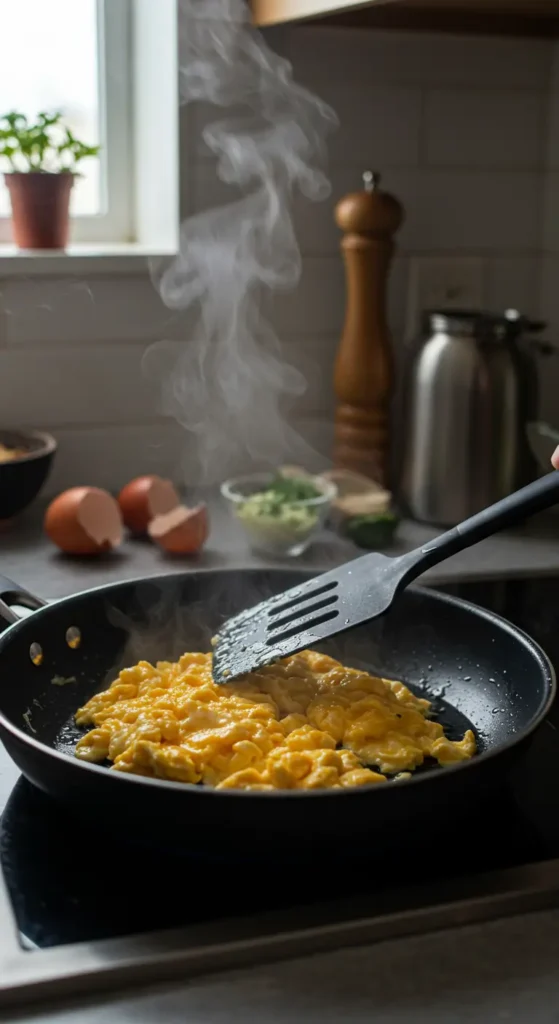
The Bottom Line :
Look, scrambled eggs aren’t complicated. But they’re also not as foolproof as everyone pretends they are. Low heat, good fat, patience, and don’t overthink it. That’s literally it.
If you’ve been making rubber eggs like I was, try this method. Just once. What’s the worst that could happen? You waste three eggs and learn something new.
And if you nail it on the first try, congratulations—you’re officially better at breakfast than I was for most of my adult life. Enjoy your fluffy, creamy, actually-good scrambled eggs. You’ve earned them.
Now excuse me while I go make my third batch of eggs this week. What can I say? I’m making up for lost time.
Happy egg scrambling! 🍳
(P.S. – If you have any secret scrambled egg tips, please share them. I’m always looking to up my breakfast game even more!)
Perfect Fluffy Scrambled Eggs
Learn the secret to making perfect scrambled eggs that are fluffy, creamy, and never rubbery. Low heat and patience are key to these restaurant-quality eggs you can make at home.
Ingredients
- 3 large eggs
- 2-3 tablespoons butter
- 2-3 tablespoons heavy cream or milk
- Salt to taste
- Freshly ground black pepper to taste
Instructions
- Step 1Crack eggs into a bowl and add cream, salt, and pepper. Whisk vigorously until pale yellow and slightly frothy.
- Step 2Heat non-stick pan on low heat. Add butter and let it melt slowly without browning or sizzling.
- Step 3Pour egg mixture into pan and let sit for 30 seconds without stirring.
- Step 4Using a silicone spatula, gently push eggs from outer edges toward center, tilting pan to let liquid egg flow underneath.
- Step 5Continue cooking slowly for 5-8 minutes, stirring gently and patiently until eggs are almost set but still slightly wet.
- Step 6Remove from heat while eggs are still slightly underdone. They will continue cooking from residual heat.
- Step 7Give final gentle stir and serve immediately.

